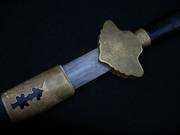Maintaining a steel sword

Resin-free oils should be used on principle. Camellias oil is most suitable. The blade should be cleaned after each training or test cutting with a soft tissue and a little bit alcohol (benzine).
Fingerprints (as a general rule, you should not touch the blade) or residues (test cutting) like resins, wood fibres and plastic are for instance removed in this way. The blade should be coated with a thin layer of oil after the cleaning (rust protection).
Chemical cleaning agents or standard abrasive polishing compounds should be used under no circumstances.
If you train a lot you will always be happy about a shiny and sharp blade. Rusty blades are a sign of wrong storage and inadequate care.
Maintaining a wooden sword
The wooden sword should be checked for cracks and splinters after the training and if necessary mended with fine grid sandpaper. The mended spot should finally be treated with oil.

The wooden sword should be checked for cracks and splinters after the training and if necessary mended with fine grid sandpaper. The mended spot should finally be treated with oil.
A new wooden sword gets more elasticity and breaking strength if it is cared for with tung / linseed oil
• daily in the first week
• once a week in the first month
• once a month in the first year
• after that from time to time
Please remove excess oil always immediately. Safety procedures must be observed, since oil-soaked tissues are highly inflammable in connection with oxygen. A mixture at a ratio of 1 to 1 guarantees the best protection. The same effect is reached as with a forged blade: hard on the outside and flexible on the inside. Please do never use tung / linseed oil for steel blades.
